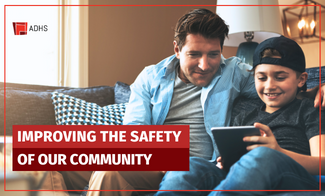 Public health draws on a science base that is multi-disciplinary. This allows us to gather knowledge from a broad range of disciplines including medicine, epidemiology, sociology, psychology, criminology, education, and economics. Coupled with a cross-sector approach, public health is poised to tackle violence prevention that strives to provide the maximum benefit for the largest number of people. Experiencing any forms of injury or violence can directly impact the mental health and well-being of the individual experiencing them as well as individuals witnessing them and even whole communities.
Public health draws on a science base that is multi-disciplinary. This allows us to gather knowledge from a broad range of disciplines including medicine, epidemiology, sociology, psychology, criminology, education, and economics. Coupled with a cross-sector approach, public health is poised to tackle violence prevention that strives to provide the maximum benefit for the largest number of people. Experiencing any forms of injury or violence can directly impact the mental health and well-being of the individual experiencing them as well as individuals witnessing them and even whole communities.
The 2021 Youth Risk Behavior Survey found that more than 17% of Arizona youth were bullied on school property. Almost 20% of youth reported being electronically bullied. Significant long-term implications for victims of bullying include mental trauma and suicidal ideation, as well as decreased school performance. Those who bully can also experience negative health outcomes that may last into adulthood, such as early sexual activity, substance abuse, and domestic violence. While certain groups of children may be at higher risk of being bullied, the impact is the same no matter whose child is the victim. Evidence-based programs may be used by schools, families, or communities to help alleviate or eliminate the prevalence and effect bullying has on children and their environments.
We know how critical it is to incorporate mental health approaches into bullying prevention efforts. Showing the positive effects of being kind and accepting of others is just one aspect of ADHS’ approach to bullying prevention. The Must Stop Bullying website offers resources to help parents, youth, and schools intervene in bullying situations.
Among adults, data from the CDC’s National Intimate Partner and Sexual Violence Survey indicate that about 41% of women and 26% of men nationwide experience sexual violence, physical violence, and/or stalking by an intimate partner during their lifetime. ADHS addresses sexual and domestic violence with support from the federal Family Violence Prevention and Services Act (FVPSA), Violence Against Women Act (VAWA), and the Preventive Health and Health Services Block Grant. FVPSA-funded programs across the state provide critical, culturally-responsive services to victims of domestic violence and their families. Our partners include statewide community based organizations, domestic violence shelters, community health centers, universities, local county health departments, Arizona Department of Economic Security, Arizona Coalition to End Sexual and Domestic Violence, statewide tribal domestic violence coalitions, and other partners statewide. In addition, ADHS’ Sexual Violence Prevention and Education Program (SVPEP) funds local community based partners, two of the state’s universities, and a local county health department to implement prevention efforts that decrease sexual violence in communities most at risk (e.g. youth 13-17 years old, students attending college, racial/ethnic populations).
Using public health-based interventions can make a difference in the reduction of violence. ADHS programs continue to seek out opportunities that improve the health and safety of all individuals. For example, home visiting programs incorporate domestic violence screening and home visitation models have been shown to reduce the risk of child maltreatment. In addition, the annual Arizona Child Fatality Review Report includes recommendations to prevent deaths due to abuse and neglect, firearms, and suicide. Addressing underlying risk factors decreases likelihood that an individual will become a victim or a perpetrator of violence.
Resources are available to support a variety of situations. The 988 Suicide & Crisis Lifeline offers 24/7 call, text, and chat access to trained crisis counselors who can help people experiencing suicidal, substance-related, and/or mental health crises, or any other emotional distress. 988 Counselors in Arizona are trained to assist with a variety of issues including violent or abusive situations, grief and loss, or finding a safe place. They can also answer questions about how to support a loved one. Resources are available from a variety of partners and agencies to support anyone who feels unsafe at home or has experienced sexual violence.
While they may seem unrelated to each other, all these forms of violence are related through shared risk and protective factors, meaning they often share the same contributing factors and root causes. But there’s an upside, too: increasing one positive factor, such as strong interpersonal, school, or community connections protects against experiences of violence. To read more on this topic, visit the CDC’s Connecting the Dots site.
Addressing violence as a public health issue can seem like a daunting task, but it’s important to remember that violence IS preventable. The public health approaches we apply to chronic disease and other negative health outcomes can also be applied to violence.










